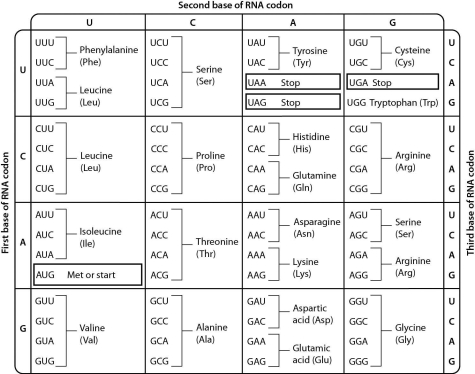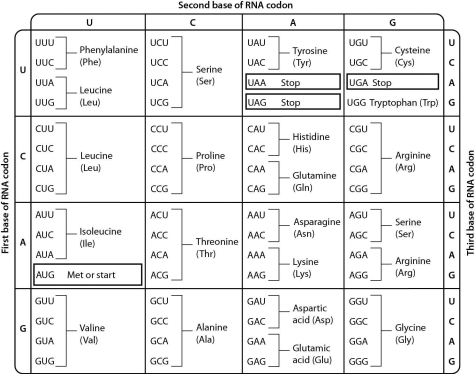A) RNA splicing
B) the removal of exons
C) the lack of RNA-digesting enzymes in the cytoplasm
D) a cap and tail
Correct Answer

verified
Correct Answer
verified
Multiple Choice
Plant viruses ________.
A) often use RNA,rather than DNA,as their genetic material
B) benefit plants,rather than causing disease
C) cause diseases that can be easily cured
D) do not exist,as viruses attack only animals
Correct Answer

verified
Correct Answer
verified
Multiple Choice
In a DNA double helix,adenine pairs with ________ and guanine pairs with ________.
A) cytosine...thymine
B) guanine...adenine
C) thymine...cytosine
D) uracil...cytosine
Correct Answer

verified
Correct Answer
verified
Multiple Choice
RNA contains the nitrogenous base ________ instead of ________,which is found only in DNA.
A) a deoxyribose sugar...a ribose sugar
B) uracil...thymine
C) uracil...guanine
D) thymine...uracil
Correct Answer

verified
Correct Answer
verified
Multiple Choice
How can bacteriophage DNA be spread from cell to cell without causing cell death?
A) by altering the way a cell splices its RNA
B) via a lytic cycle
C) via a lysogenic cycle
D) by changing the length of its DNA molecules
Correct Answer

verified
Correct Answer
verified
Multiple Choice
If one strand of a DNA double helix has the sequence GTCCAT,what is the sequence of the other strand?
A) ACTTGC
B) TGAACG
C) CAGGTA
D) CAGGUA
Correct Answer

verified
Correct Answer
verified
Multiple Choice
If adenine makes up 20% of the bases in a DNA double helix,what percent of the bases is guanine?
A) 60%
B) 40%
C) 20%
D) 30%
Correct Answer

verified
Correct Answer
verified
Multiple Choice
Flu vaccines have been demonstrated to protect the elderly,as shown in the figure below.Assume there is a sample of 100 elderly people that normally would be hospitalized in winter.How many of them would you predict would still be hospitalized in the winter if all 100 of them received the flu vaccine? 
A) 27
B) 48
C) 52
D) 73
Correct Answer

verified
Correct Answer
verified
Multiple Choice
Examine the genetic code table shown below.The codon AGC codes for the amino acid ________. 
A) serine
B) arginine
C) threonine
D) alanine
Correct Answer

verified
Correct Answer
verified
Multiple Choice
The DNA codon AGT codes for an amino acid carried by a tRNA with the anticodon ________.
A) TCU
B) AGU
C) TCA
D) AGT
Correct Answer

verified
Correct Answer
verified
Multiple Choice
Evidence for the spiral nature of DNA came from ________.
A) X-ray crystallography studies
B) studies of disease-causing bacteria
C) base rule studies
D) bacteriophage studies
Correct Answer

verified
Correct Answer
verified
Multiple Choice
HIV (human immunodeficiency virus) must use its own ________ to reproduce.
A) DNA polymerase
B) reverse transcriptase
C) RNA polymerase
D) tRNA
Correct Answer

verified
Correct Answer
verified
Multiple Choice
How many amino acids are common to all living systems?
A) 10
B) 20
C) 30
D) 100
Correct Answer

verified
Correct Answer
verified
Multiple Choice
An mRNA is expressed that begins with the sequence AUGCCAGGCGUC.Using the genetic code below,determine what peptide will be translated from this mRNA. 
A) Met - Pro - Gly - Val
B) Met - Gly - Pro - Val
C) Pro - Met - Val - Gly
D) Val - Gly - Pro - Met
Correct Answer

verified
Correct Answer
verified
Multiple Choice
The backbone of DNA consists of ________.
A) nitrogenous bases
B) a repeating sugar-nucleotide-sugar-nucleotide pattern
C) a repeating sugar-phosphate-sugar-phosphate pattern
D) paired nucleotides
Correct Answer

verified
Correct Answer
verified
Multiple Choice
Peptide bonds form between ________.
A) amino acids
B) an mRNA codon and a tRNA anticodon
C) a tRNA and the amino acid it is carrying
D) an mRNA transcript and the small ribosomal subunit
Correct Answer

verified
Correct Answer
verified
Multiple Choice
What name is given to the collection of traits exhibited by an organism?
A) genome
B) genotype
C) phenotype
D) genetic code
Correct Answer

verified
Correct Answer
verified
Multiple Choice
The region of DNA where RNA synthesis begins is the ________.
A) start codon
B) promoter
C) stop codon
D) terminator
Correct Answer

verified
Correct Answer
verified
Multiple Choice
As an experiment,you infect bacteria with an unknown virus to see how the bacteriophage affects the bacteria.After a few days,you notice that the bacterial population is growing normally and that the cells appear healthy.Assuming that the infection occurred,what can you conclude from your observations?
A) The virus is a bacteriophage that is reproducing the lytic cycle.
B) The virus is a retrovirus that is reproducing the lytic cycle.
C) The virus is a bacteriophage that is reproducing the lysogenic cycle.
D) The virus is a retrovirus that is reproducing the lysogenic cycle.
Correct Answer

verified
Correct Answer
verified
Multiple Choice
During translation,what is the CORRECT order of events that occur as an amino acid is added?
A) codon recognition,peptide bond formation,translocation
B) translocation,codon recognition,termination
C) initiation,codon recognition,termination
D) peptide bond formation,translocation,codon recognition
Correct Answer

verified
Correct Answer
verified
Showing 21 - 40 of 53
Related Exams